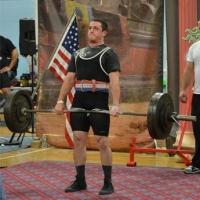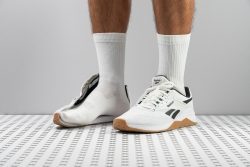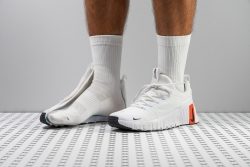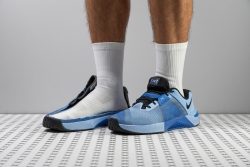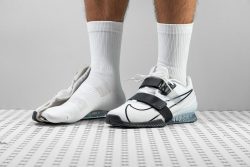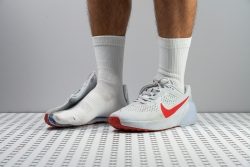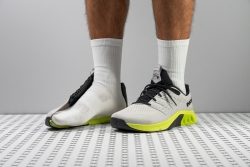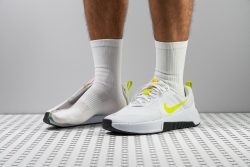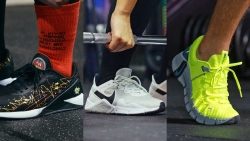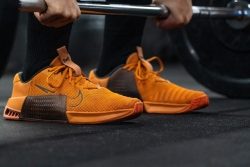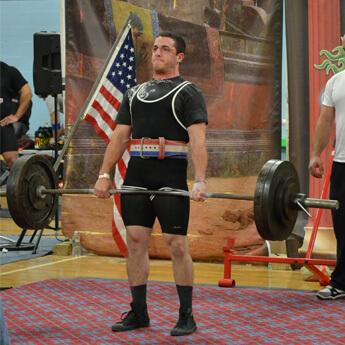7 Best Gym Shoes For Women in 2025
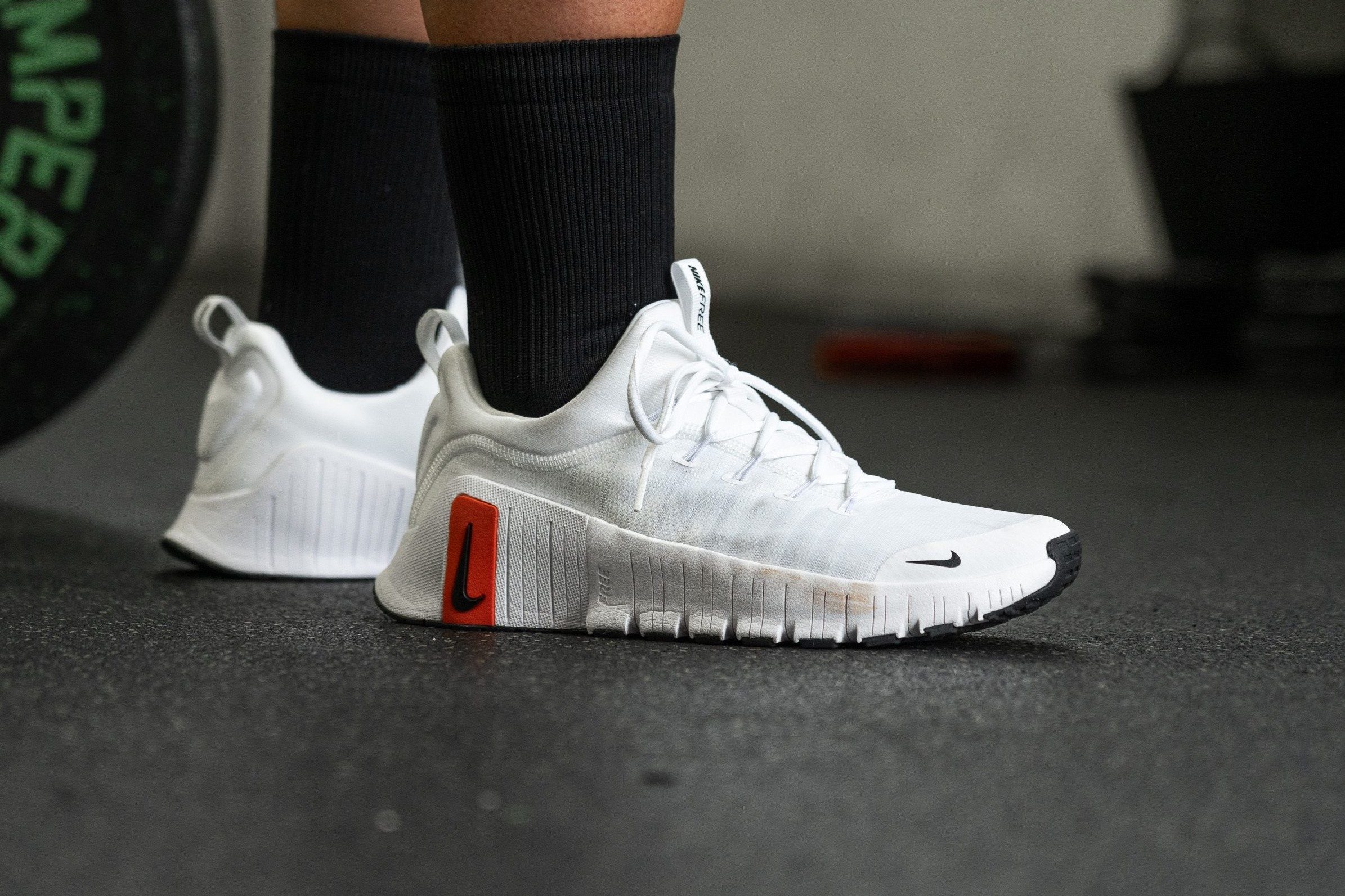
We buy shoes ourselves. We earn commissions when you buy through us, at no extra cost. Why trust us
Wearing the right women’s gym shoe feels like a game changer. Just like a good sports bra, a well-fitting pair of trainers takes your workout sessions to a whole new level.
Whether you need a do-it-all CrossFit shoe or a light and cushioned trainer for cardio workouts, we have tested dozens of women’s trainers in and out of our lab to pick the best ones in several categories.
How we test gym shoes for women
We are on a mission to provide you with the most unbiased information on every women’s gym shoe and how it actually performs. No matter what logo it carries or how many times you’ve seen it on a fitness influencer’s Instagram.
Our testing process includes the following steps:
- Purchasing every gym shoe using our own funds. No brand loyalty or sponsorships.
- Testing each trainer thoroughly in a variety of workout routines.
- Taking each shoe apart in our lab to study its construction and measure every measurable parameter.
As a result, we can provide you with objective and comparable data on each shoe’s stability, shock absorption, fit, breathability, durability, traction, and other characteristics. This research gives us a solid basis for picking the best women’s gym shoes to feature in this guide.
Best gym shoes for women overall
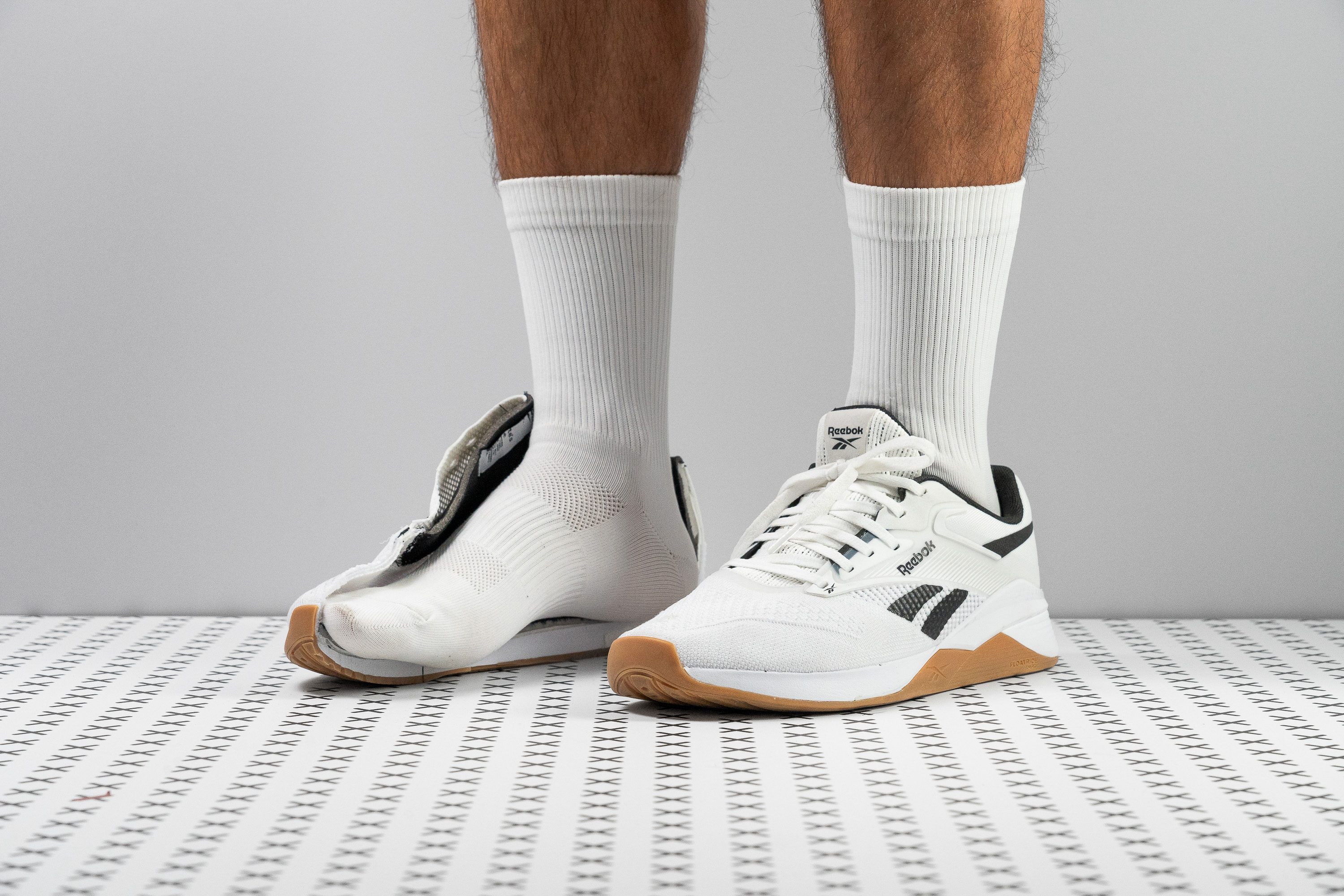













































What makes it the best?
The Reebok Nano X4 has a tough exterior yet gentle interior, which makes transitioning from lifting to cardio work a breeze. It’s easily our top women’s gym trainer. We can go full force with weights thanks to the Lift and Run Chassis and perform various exercises worry-free because of the impact protection and exceptional all-around durability of the shoe, which we proved in the lab.
The platform gives much-needed impact protection and bounce during jumps and runs, courtesy of the 26.0/17.4 mm stack and high energy return scores of 61.0% (heel) and 58.4% (forefoot) we measured.
For quick footwork and lateral movements, we felt in control because of the shoe’s Lift and Run Chassis, which adds structure to the shoe, evidenced by its 4/5 torsional rigidity rating. Women seeking a secure foothold will enjoy this pair.
From rope climbs to outsole friction to careless heel rubs, Nano X4 is built to last. It scored a 4/5 in our Dremel test in the toebox and heel, and only ended up with a minimal 0.5 mm dent in the outsole vs. the 1.1 mm average. Any doubts we had regarding longevity were erased.
As a versatile trainer, it’s not the best option for more serious running and weightlifting. Women with more specific needs should try other options.
Pros
- Fantastic wear resistance
- Great balance of cushioning and stability
- Feels grounded and supportive
- Secure foot lockdown
- A fully-gusseted tongue (finally)
- Nice breathability
- Lighter than the X3
- Great grip on gym floors
Cons
- Not for heavy lifting
- Not for wide feet
Best women's gym shoes for HIIT






















































What makes it the best?
The Nike Free Metcon 6 has got to be one of the most versatile trainers we’ve tested. It’s exceptionally stable while allowing room for foot bending, as seen in our lab tests. It’s really light yet offers unwavering support and responsiveness, making it our ultimate HIIT gym shoe for women.
At only 9.7 oz (274g), it feels pleasantly light on foot for all the support it offers. Its weightlessness is further enhanced by its unmatched flexibility. Needing only 9.0N to bend to 30 degrees, 18.9% less than average, it’s one of the most flexible trainers in our lab. We felt like we had no shoes while performing lunges and burpees.
The Metcon in its name comes alive with its wide and stable midsole, perfect for women seeking support without discomfort. Amazingly, it managed to isolate the firm 27.8 HA foam under the heel for stability, while keeping the rest of the midsole a more cushioned and bouncy 22.5 HA.
We brought out our callipers and measured the base to be a massive 113.9/94.4 mm, which made us feel connected to the ground. No matter how quick and intense our footwork got, our lateral motions were contained.
While great for HIIT workouts, women who need generous cushioning for heavy cardio will find this trainer underwhelming.
Pros
- Fantastic breathability
- Very light on foot (lighter than average too)
- Abundant cushioning for HIIT
- Most flexible cross-trainer ever
- Excellent stability for moderate weightlifting
- Sock-like fit in a bootie upper
- Accommodating toebox (for medium feet)
- Great grip on gym surfaces
Cons
- NOT for rope climbs (lacks protection)
- Can be hard to put on (narrow opening)
Best women's gym shoes for Crossfit
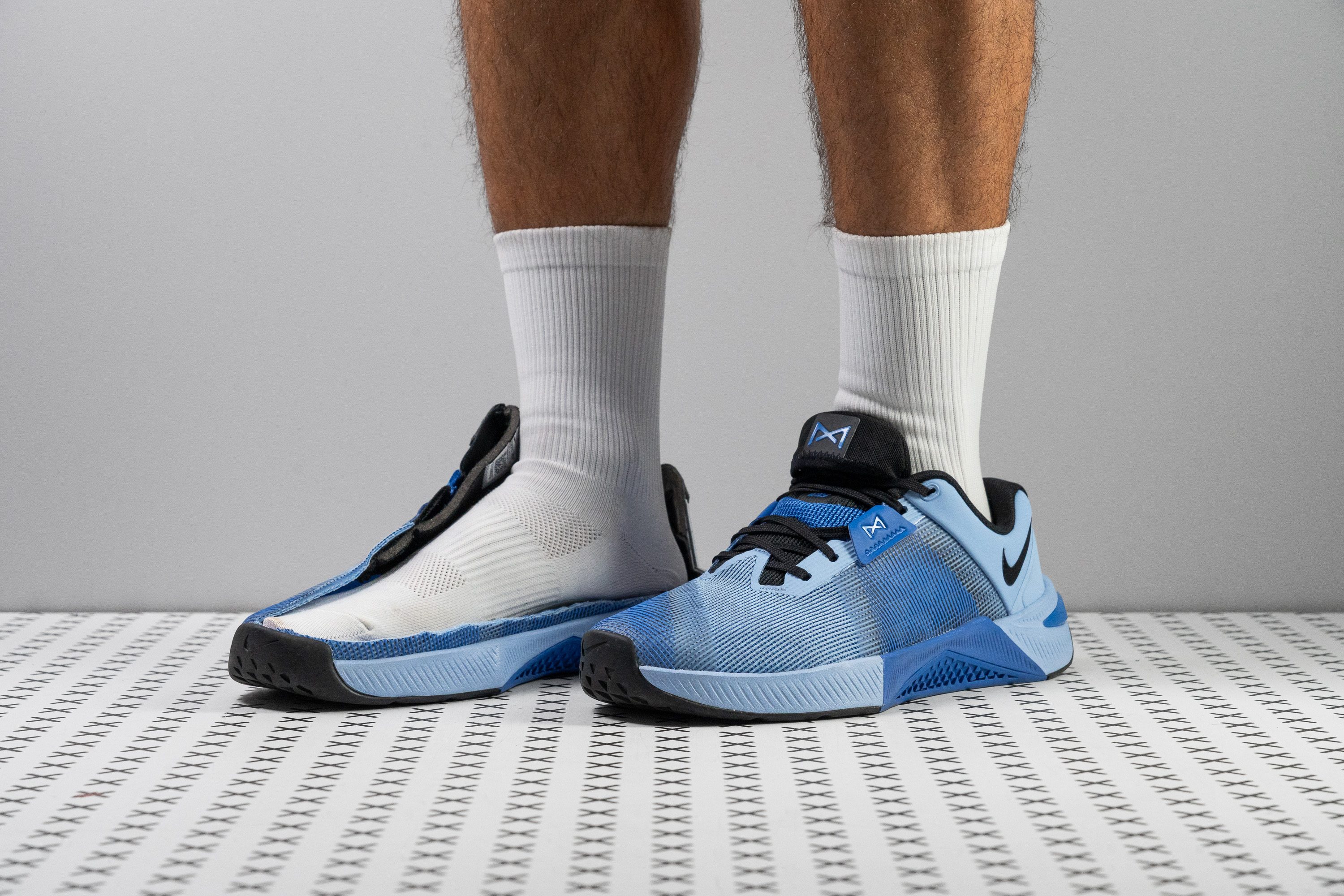














































What makes it the best?
Through countless reps of exercises and hours in the lab, we chose the Nike Metcon 10 as a girl’s best bet for CrossFit among gym shoes. For the solid stability it offers, it surprisingly feels light and smooth underneath, allowing us to perform a wide range of movements in a smooth and effortless manner.
This trainer offers high ground feel and undeniable support through its low profile and locked-in fit. It features a minimal 22.8/16.2 mm stack, with a firm Hyperlift insert in the heel so that the platform doesn’t collapse under a heavy barbell. In addition, its midfoot band works together with the sturdy upper to keep our feet centred, perfect for women seeking stability.
Thankfully, its torsional rigidity doesn’t get in the way of foot-bending activities like burpees and planks. In fact, it emerged 13.2% more flexible than average in our bend test, proving it’s easy to manoeuvre.
Plus, it’s surprisingly light for a shoe that’s capable of some heavy weightlifting. Our scales show it’s only 11.0 oz (312g), which explains why it never burdened our feet during quick footwork and agility drills.
Unfortunately, the upper traps heat and don’t give our feet room to breathe. Women who want to avoid overheating and dealing with tonnes of sweat should find a more ventilated trainer.
Pros
- More versatile Metcon overall
- One of the lightest Metcons ever!
- ReactX adds shock absorption and energy return
- Increased forefoot flexibility
- Still amazingly stable for weightlifting
- Fantastic upper durability (even for rope climbs)
- Great grip on gym floors
- Highly secure foot lockdown
- Accommodating fit and toebox
- Handy Lace Tuck
Cons
- Outsole could be more durable
- Upper lacks breathability
Best women's gym shoes for weightlifting
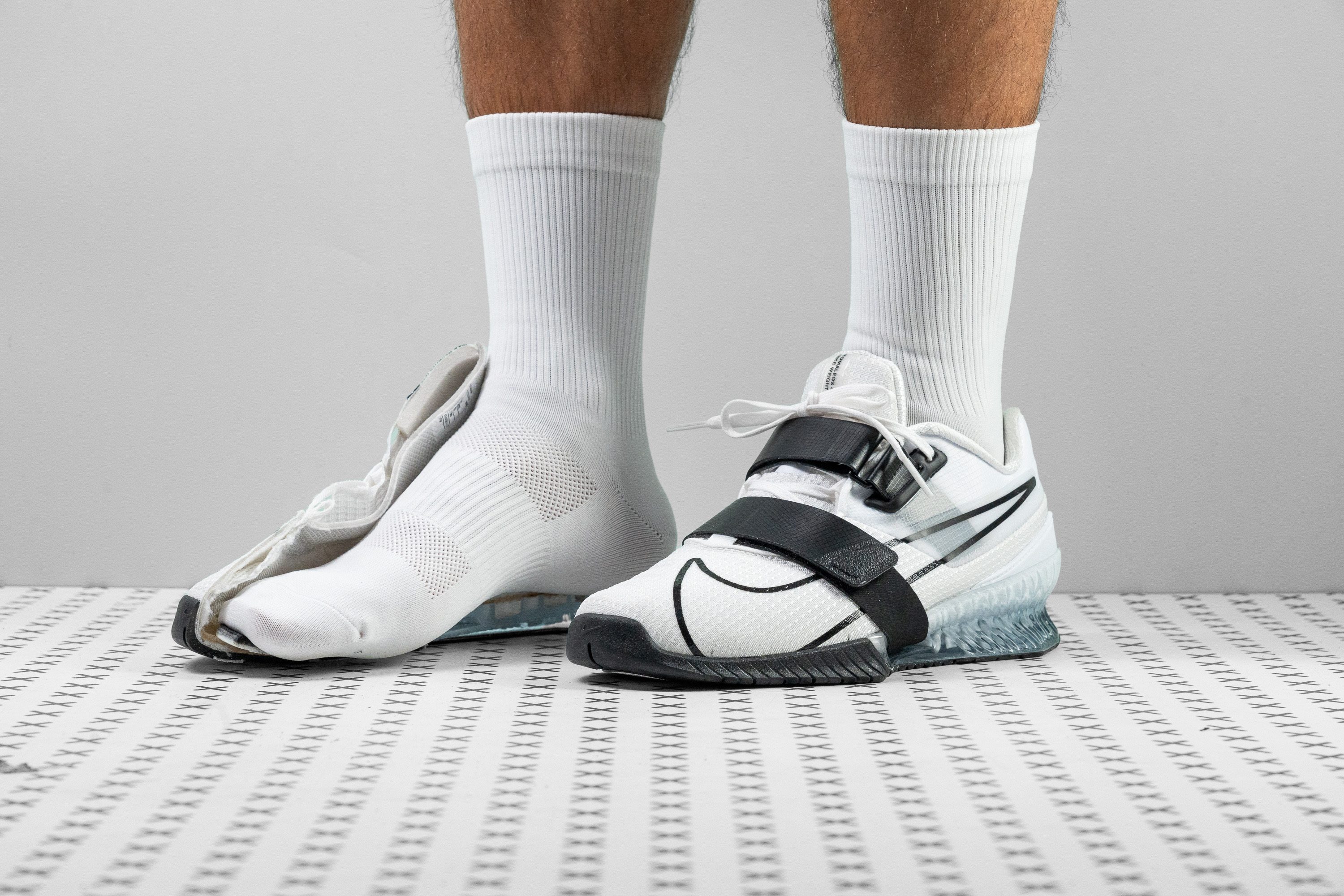






























What makes it the best?
No foam compressions and toppling over, the Nike Romaleos 4 gave us such a secure foothold that we felt confident to go for our PR weight. Our lab tests show its solid support through its vast and sturdy base, making it our best weightlifting gym shoe for women.
Using our calliper, we found that the platform has a steep 20.5 mm drop. The elevated heel helps us achieve better posture and improves our ergonomics for lifting. Our durometer shows the cushion is 40.2% firmer than average, ensuring it will never collapse under heavy loads.
The base is a wide 111.5/91.3 mm, allowing us to plant our feet firmly on the ground. It features two Velcro straps arranged in opposite directions for better adjustment and an extra stiff heel for effective foot containment. Women who don’t mind all the stiffness for undeniable support will appreciate this trainer’s structure that earned the maximum 5/5 torsional rigidity score.
However, women with narrower ankles should note that some heel slippage may be experienced when doing squats. If this is a dealbreaker, we recommend trying out other options.
Pros
- Phenomenal stability
- Sturdy platform and sole
- Better lockdown with two straps
- Comfortable for a lifting shoe
- True to size
- Efficient traction
- Appealing looks
Cons
- Upper lacks durability
- Not for narrow ankles
- Not breathable
Best women's gym shoes for cardio workouts
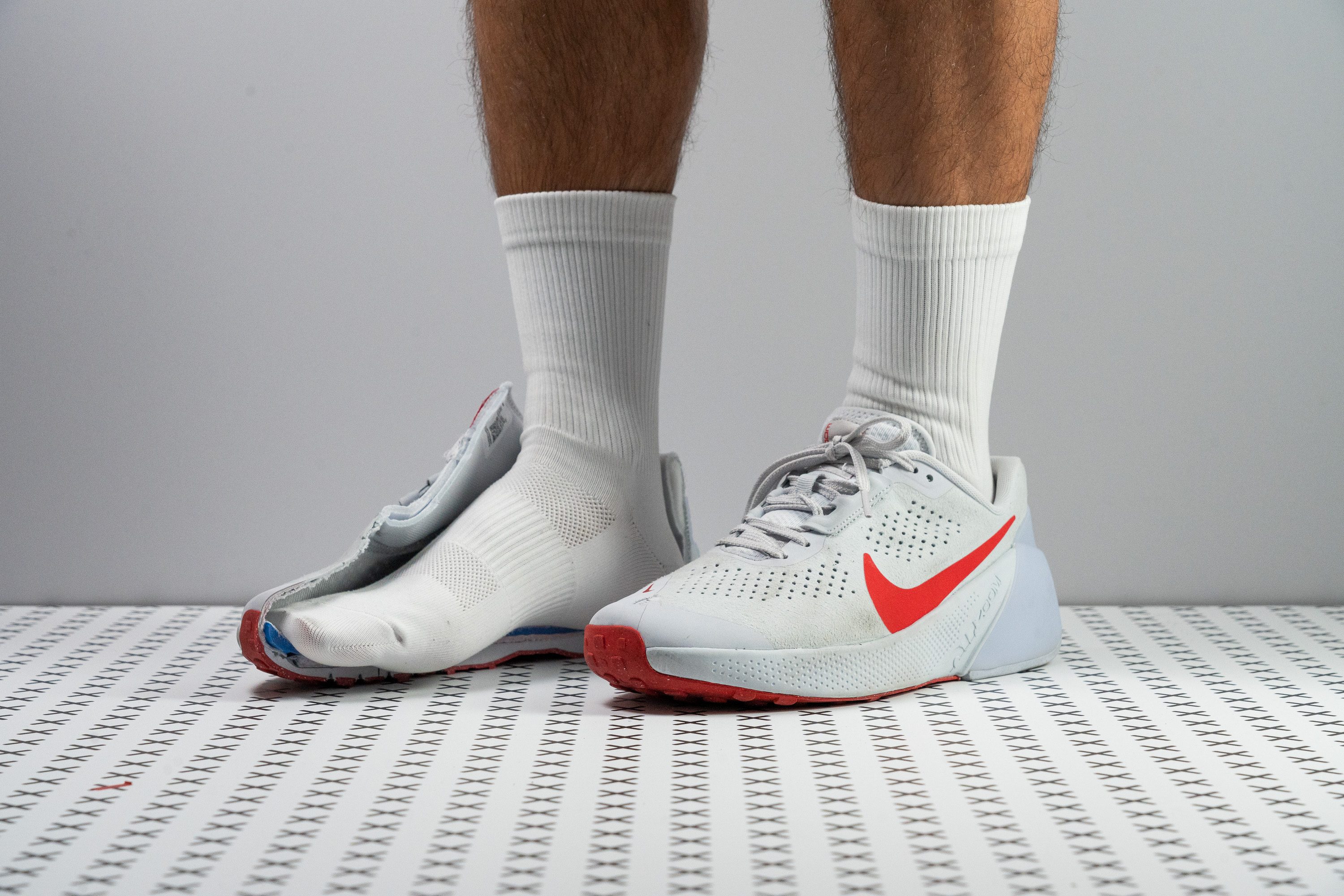











































What makes it the best?
The Nike Air Zoom TR 1 was an awesome workout partner because it’s responsive for explosive movements, highly comfortable, and has confidence-inspiring grip underneath. Our lab assessments confirm its soft yet bouncy cushion, making it our ultimate cardio gym shoe for women.
Combining energetic toeoffs with gentle landing impact, the Air Zoom TR 1 was a blessing during runs and jumps. Its soft foam kept our joints protected and ensured a zero-pain experience with its soft 20.5 HA cushion. We also discovered the Air Zoom unit that consistently offered power to our movements.
Cardio also involves burpees and mountain climbers and this trainer gives us room to do those easily. In our bend test, it emerged as flexible as the average trainer, which explains why we never had problems with foot-bending exercises.
Women who move in a heartbeat will love the sticky outsole. Even on sweaty gym floors, we could do all our footwork with precision because of the grippy rubber. Our durometer confirms it’s a soft 75.6 HC, which usually translates to better grip.
Unfortunately, it can’t keep our feet fresh during hot and humid sessions. We cannot recommend this shoe to women who prioritise breathability.
Pros
- Dependable bite on gym floors
- Pretty durable toebox
- Good impact protection
- Nice lateral stability
- Secure heel hold
- Smooth heel-to-toe transitions
- OK for occasional outdoor use
Cons
- Not breathable at all
- Not for heavy lifting
- Not for heavy lifting
Women's gym shoes with the best traction
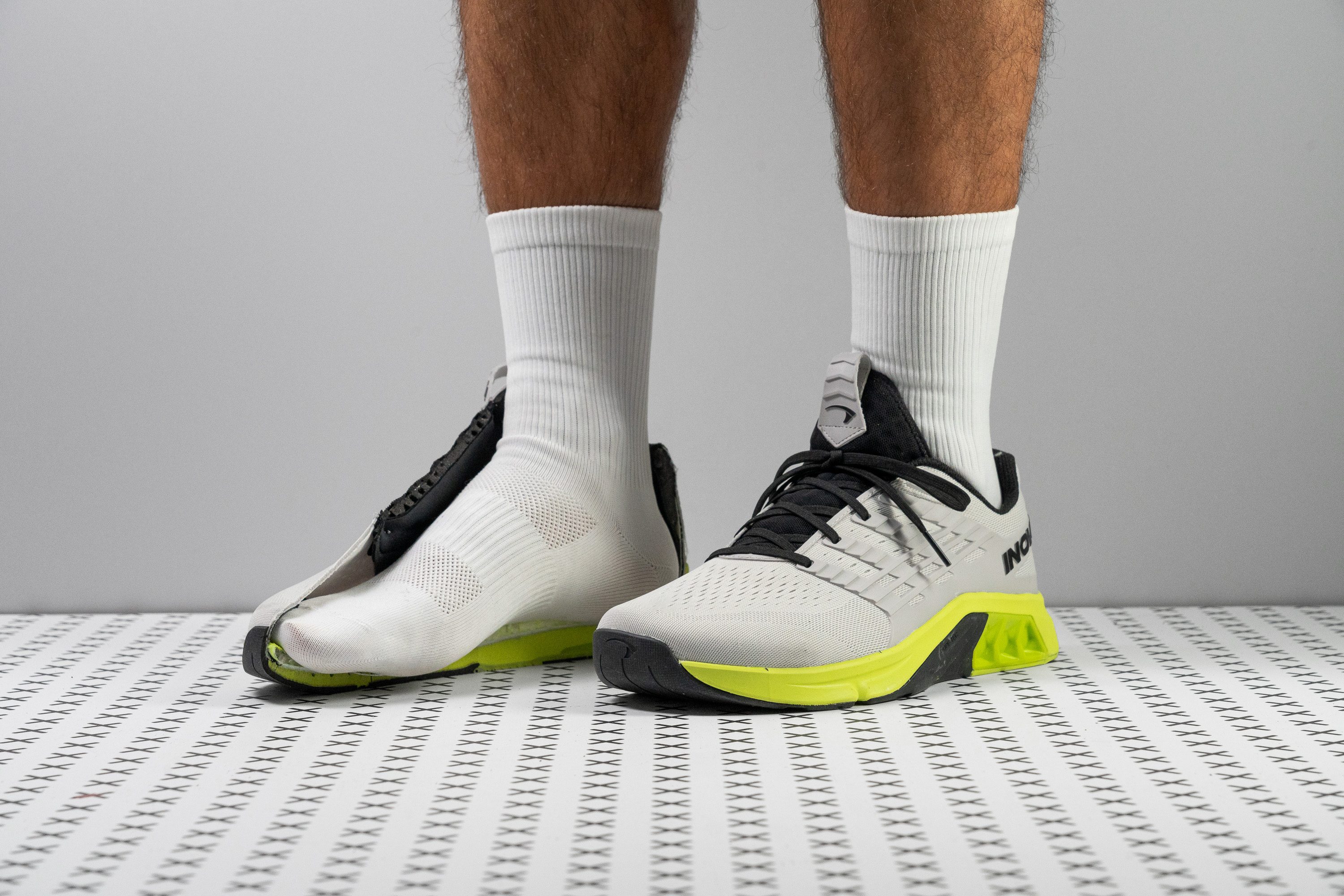























































What makes it the best?
Following countless hours in the gym and the lab, we believe women searching for the gym shoe with the best traction match the Inov8 F-Lite Max perfectly. Its sticky compound inspires confident footing, together with stabilising components that are great for lifting. Thankfully, the sturdy support doesn’t sacrifice its flexibility for other types of exercises.
Whether we performed burpees or sled pushes on sweaty gym floors or dusty hardwood, this trainer could keep up. We tested the outsole in our wet-condition test, and it earned a significantly high 0.53 friction score. At this level, its bite is 55.9% stronger than average, leaving no room for women to slip and slide.
After dissecting the midsole, we noted the TPU heel stabiliser and the Met-Cradle cage in the midfoot. These features add structure to the midsole, so that our ankles don’t twist easily during quick footwork or buckle over when lifting. When we tried to manually twist the shoe with our hands, it resisted firmly and got a 4/5 torsional rigidity score.
When it was time to perform lunges and planks, the forefoot flowed with our feet. Its low resistance to bending makes it suitable for other workouts, confirmed by our flex test with a score 6.3% more pliable than average.
The enormous toebox offers unmatched space for toe splaying. So, we can’t recommend this pair to women with narrow feet who want to achieve a secure fit.
Pros
- Fantastic stability for lifting and Crossfit
- Great for heavier lifting (stiff TPU heel)
- Awesome for wide feet
- Good forefoot flexiblity
- Highly breathable toebox
- Solid outsole durability
- Protection for rope climbs
- The stickiest outsole rubber
Cons
- Heavier than average
- Clunky and firm for HIIT/cardio
- Frail upper fabric
Women's gym shoes with the best shock absorption
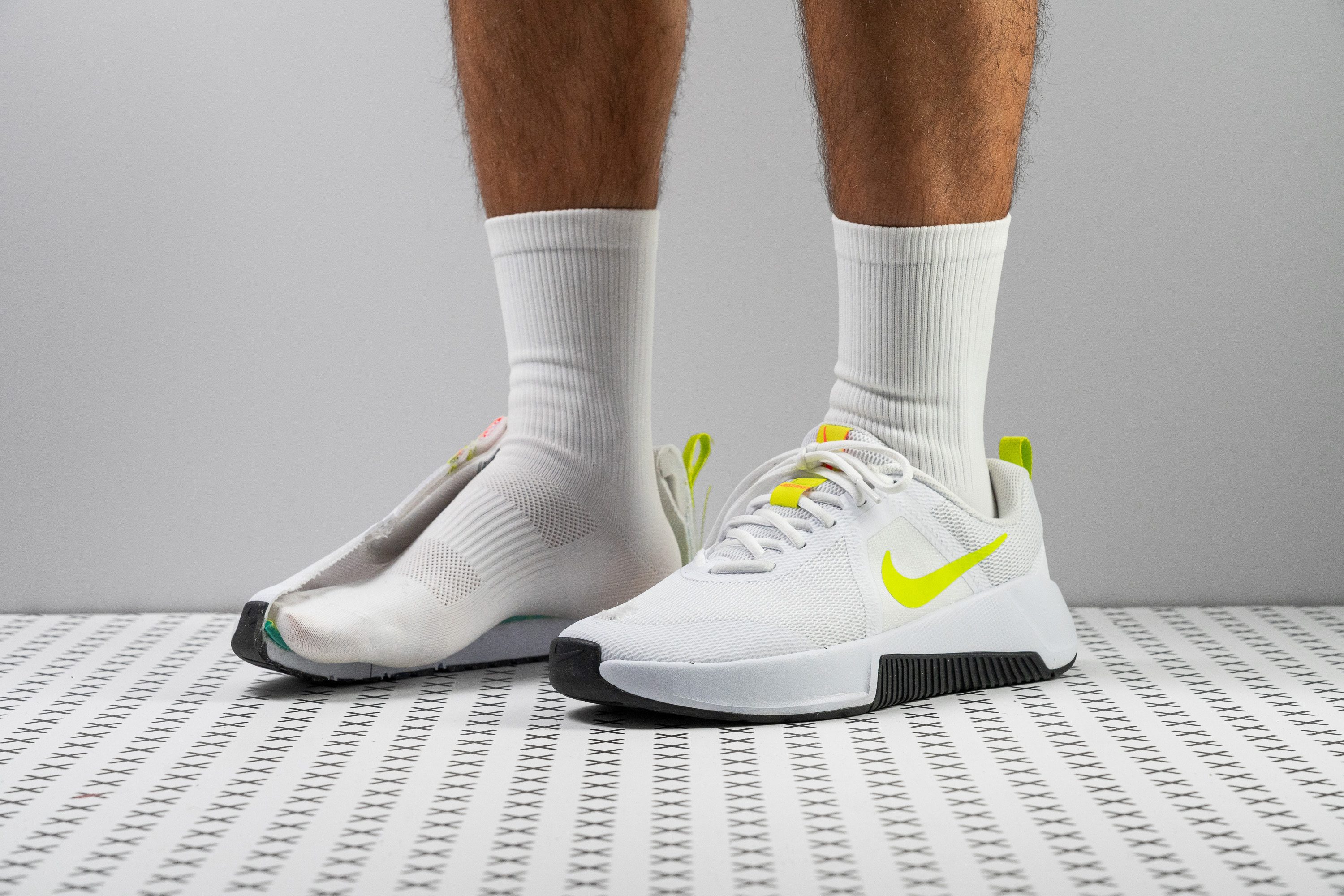

















































What makes it the best?
The Nike MC Trainer 3’s design is centred on comfort, and our feet completely agree. From its plush cushioning to its light and airy feel, our lab results prove its gentle persona. Among women’s gym shoes, it dominates shock absorption with its strain-reducing platform.
MC Trainer v3 doesn’t skimp on cushioning, and our calliper agrees with an above-average 30.6/21.8 mm stack. We barely felt the ground impact and enjoyed its luxurious touch, especially during cardio workouts. Our shock absorption test validates its joint protection with above-average scores of 97 SA (heel) and 83 SA (forefoot).
Not only is it easy on the wallet with its £80 price, but it’s lighter than average too at 10.4 oz (296g). It’s easy to manoeuvre the trainer whenever we want to speed up our footwork or lift our feet higher, perfect for agile women.
Its airiness is further enhanced by its free-flowing ventilation. Smoke rapidly escaped the upper in our breathability test, and it earned a well-deserved 5/5 score. This also boosted comfort and lessened our worries since we didn’t have to deal with sweaty feet and blisters during heated sessions.
However, what this trainer lacks is support for pronators or serious lifters. Women seeking stability should check alternatives.
Pros
- Fantastic value for money
- Highly breathable
- Doesn't drag the foot down
- Better cushioned than v2
- Heel bevel is better for running and walking
- Decent stability for moderate workouts
- Good flexibility for lunges and planks
- Accommodating toebox
- Comfortable padded interiors
Cons
- Not for flat and wide feet (narrow midfoot)
- Upper lacks wear resistance
- Weak outsole grip
Why get a proper women’s gym shoe
Setting your foot in the gym door can be overwhelming as is. But we want to make you feel more confident from day one by helping you choose the right pair of trainers.
There is a good reason why major athletic brands developed a separate category of gym footwear. These shoes are intentionally designed to handle the most common exercises that ladies perform at the gym.
And while you can get away with doing one or two sessions in your beloved pair of running kicks or sporty trainers, most of them lack the necessary features to support a serious workout programme.
Can you work out in running shoes?
Only if running on a treadmill is all you do at the gym.
It is crucial to understand that all running shoes are designed with only one movement in mind - running (duh). It is a perpetual forward motion that doesn’t involve any forceful side-to-side jumping or lifting metal objects that are 2x your body weight.
Most running shoes are horrible for gym use because:
1. They are too plush for strength training: Max-cushioned midsoles made of squishmallow foams compress very easily under any weight. This causes a lot of wobbling when you squat with a loaded barbell or do kettlebell swings.
It also makes you feel very unstable during one-legged exercises like Bulgarian split squats. Not to mention that they feel mushy and disconnected when you get on a bike during spin classes or use a rowing machine.
2. They offer little-to-no lateral support: Most running shoes lack proper support for side lunges, lateral bounds, skater hops, and many other high-impact side-to-side movements.
3. Their curved soles detract from stability: Your feet need a flat and wide platform to maintain good contact with the gym floor when working out. Toe rockers and heel bevels of running shoes make it feel like you’re trying to stand still on a rocking chair.
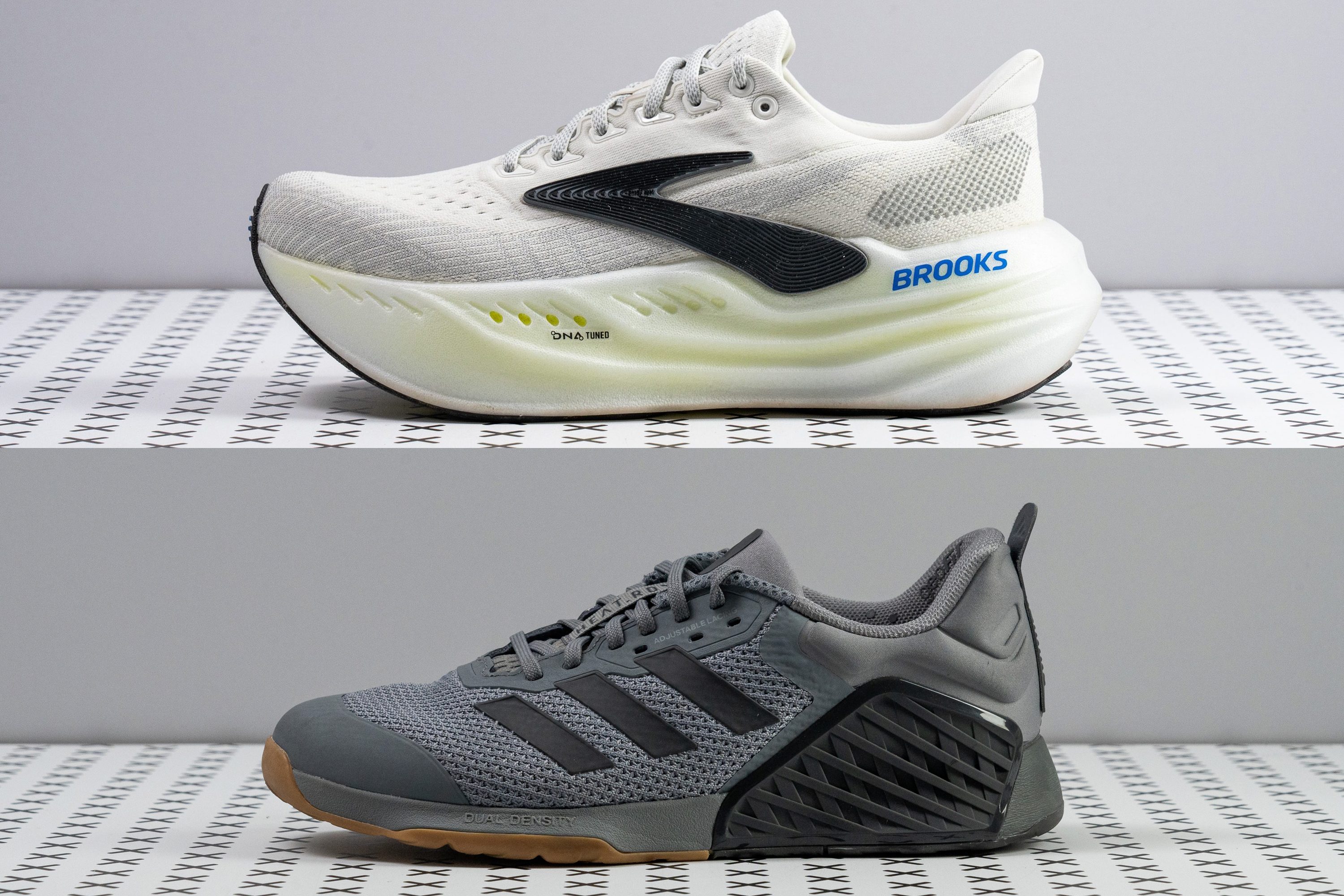
Can you work out in casual trainers?
If you try to create a mood board for a “women’s gym outfit” on Pinterest, you will see most photos featuring lifestyle trainers like New Balance retro kicks or some variation of Nike Air Max trainers. But are they actually good for working out?
Some of them, yes.
If you feel like a sneaker provides enough stability and support, impact protection for jumps, and firmness for lifting weights, there is no problem with wearing it to the gym. Especially if their style appeals to you and makes you feel motivated to keep grinding. Also, if you are in the very beginning of your fitness journey and your workouts are of light-to-moderate intensity, some trainers are fine to use (again, as long as they are supportive).
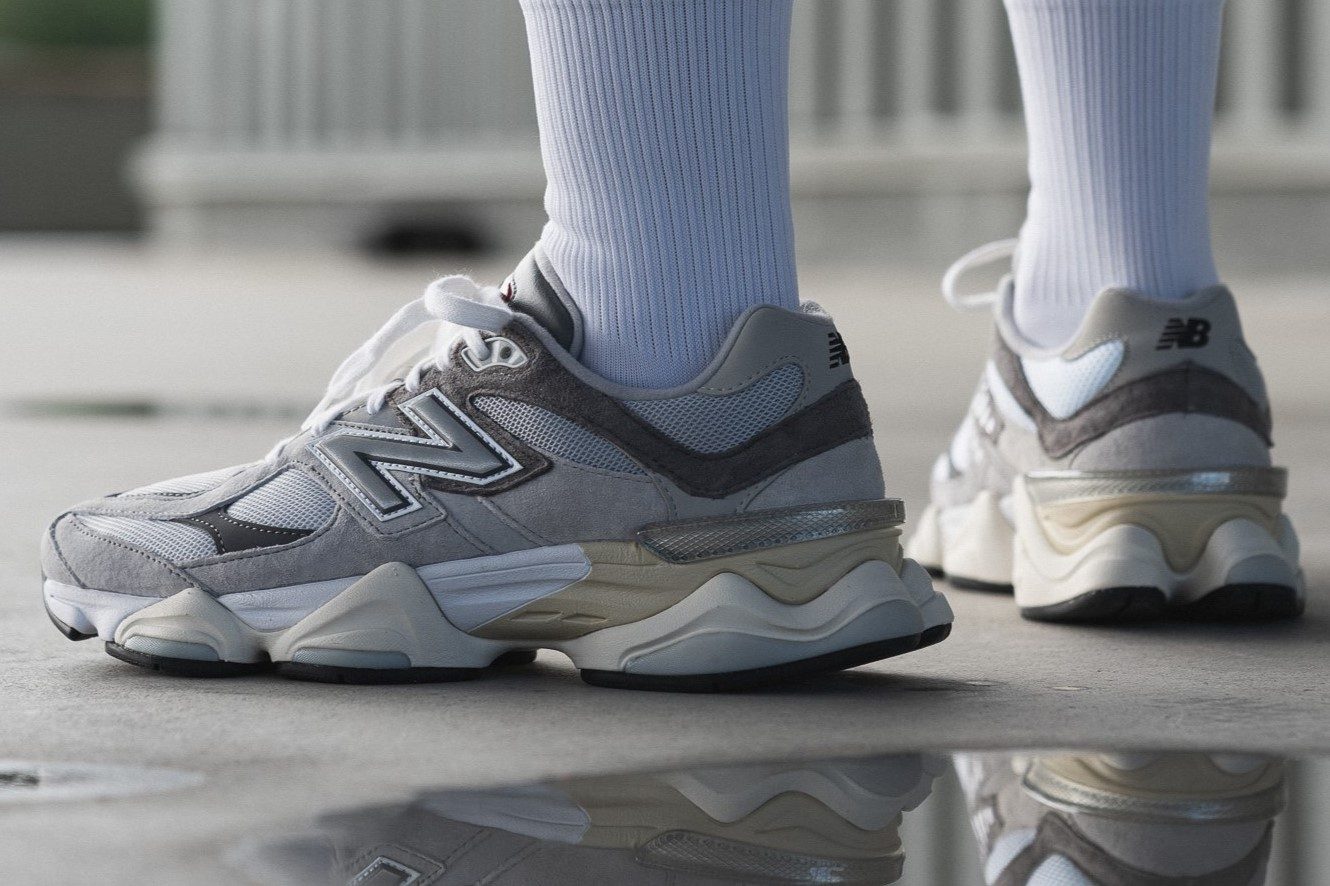
But just keep in mind that at some point in the future, you may want to switch to a more technical type of gym shoe to enhance your performance.
Are Converse Chucks good for the gym?
Many gym buffs people swear by their good old Chucks. They find the shoe’s firm and low-to-the-ground platform ideal for weightlifting and deadlifting in particular.
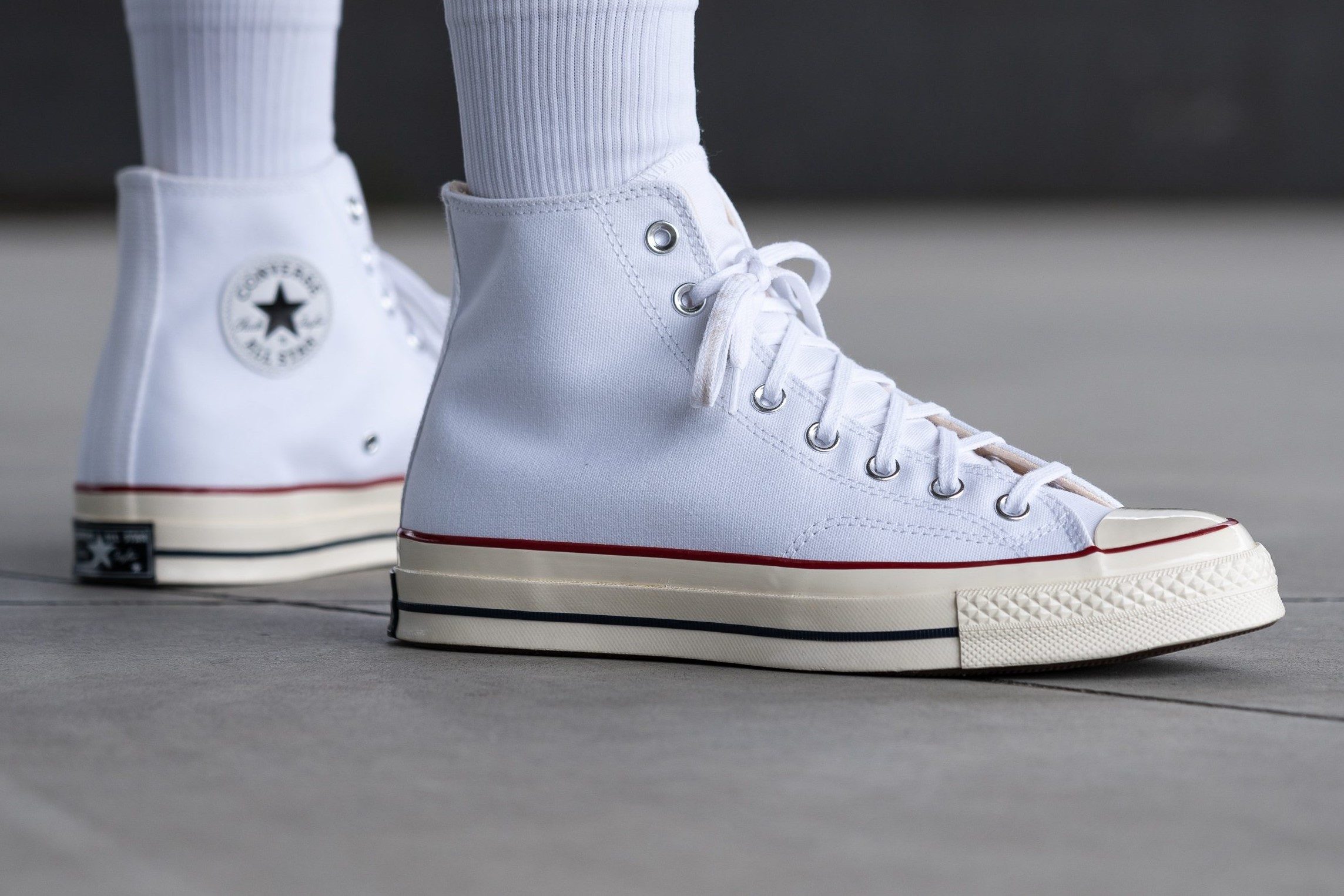
But having tested hundreds of gym shoes ourselves, we feel responsible to inform you that there are much better alternatives to this Converse sneaker (and not necessarily more expensive ones). You can find an equally stable midsole in many other trainers without having to deal with the drawbacks of this popular kick including:
- narrower-than-average platform (we measured it to be 14 mm narrower than the average training shoe in the heel!)
- extremely narrow and pointy toebox that doesn’t let your toes splay freely
- suffocating canvas upper (breathability is only 2 out of 5 based on our tests)
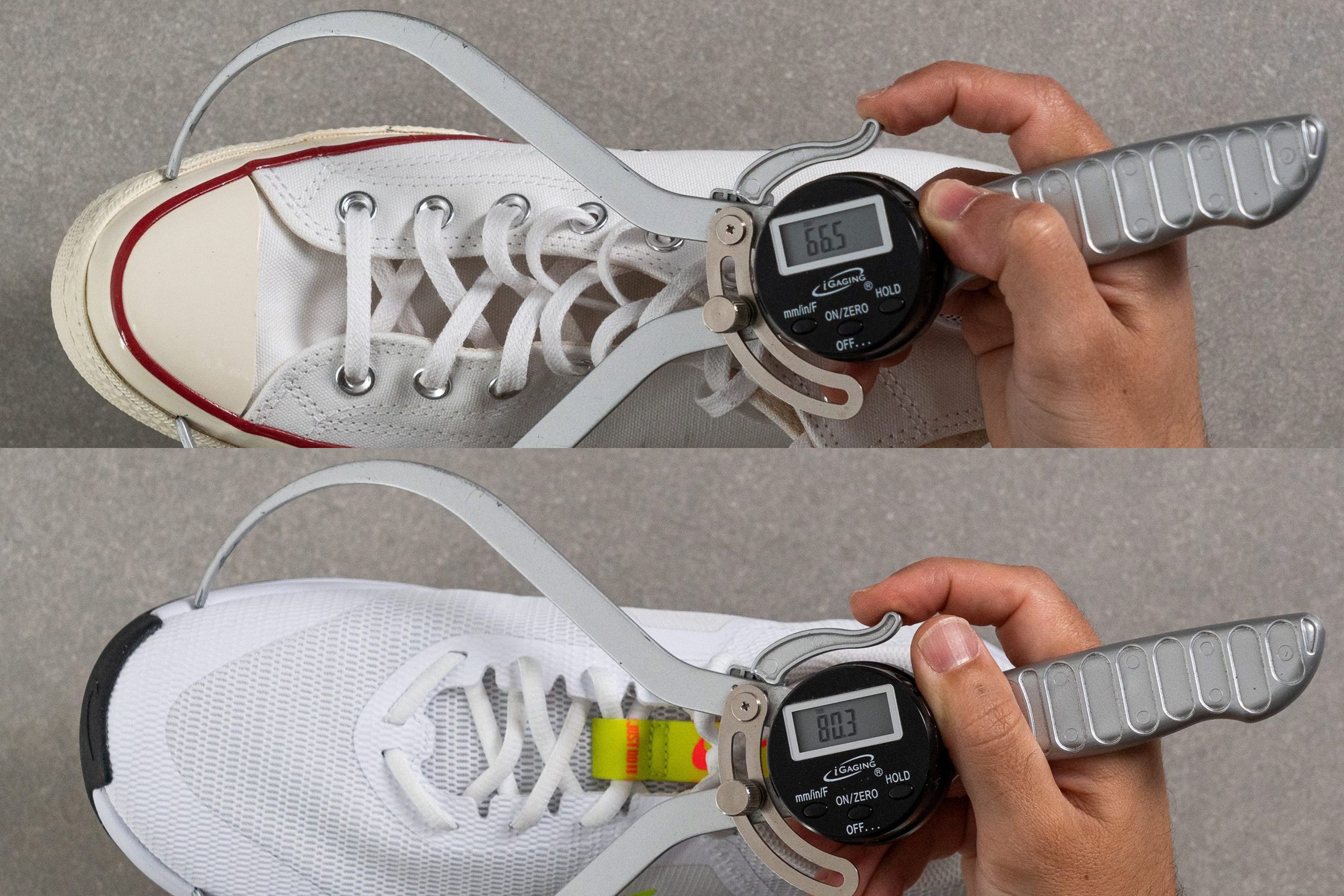
Types of women’s gym shoes
Knowing what kind of gym routine you’re going to follow determines your shoe choice 100%.
Squatting with heavy weight calls for a different kind of shoe than leisurely pacing the treadmill. For your convenience, we split all gym shoes for women into four categories based on their intended gym activity:
- versatile cross-trainers for strength and cardio
- cushioned shoes for high-impact exercises
- minimalist training shoes
- stable weightlifting shoes
1. Versatile cross-trainers for strength and cardio
Best for: Crossfit, HIIT, circuit training, functional fitness, boot camp
These training shoes are ready to tackle a wide variety of exercises at the gym, even the most vigorous routines.
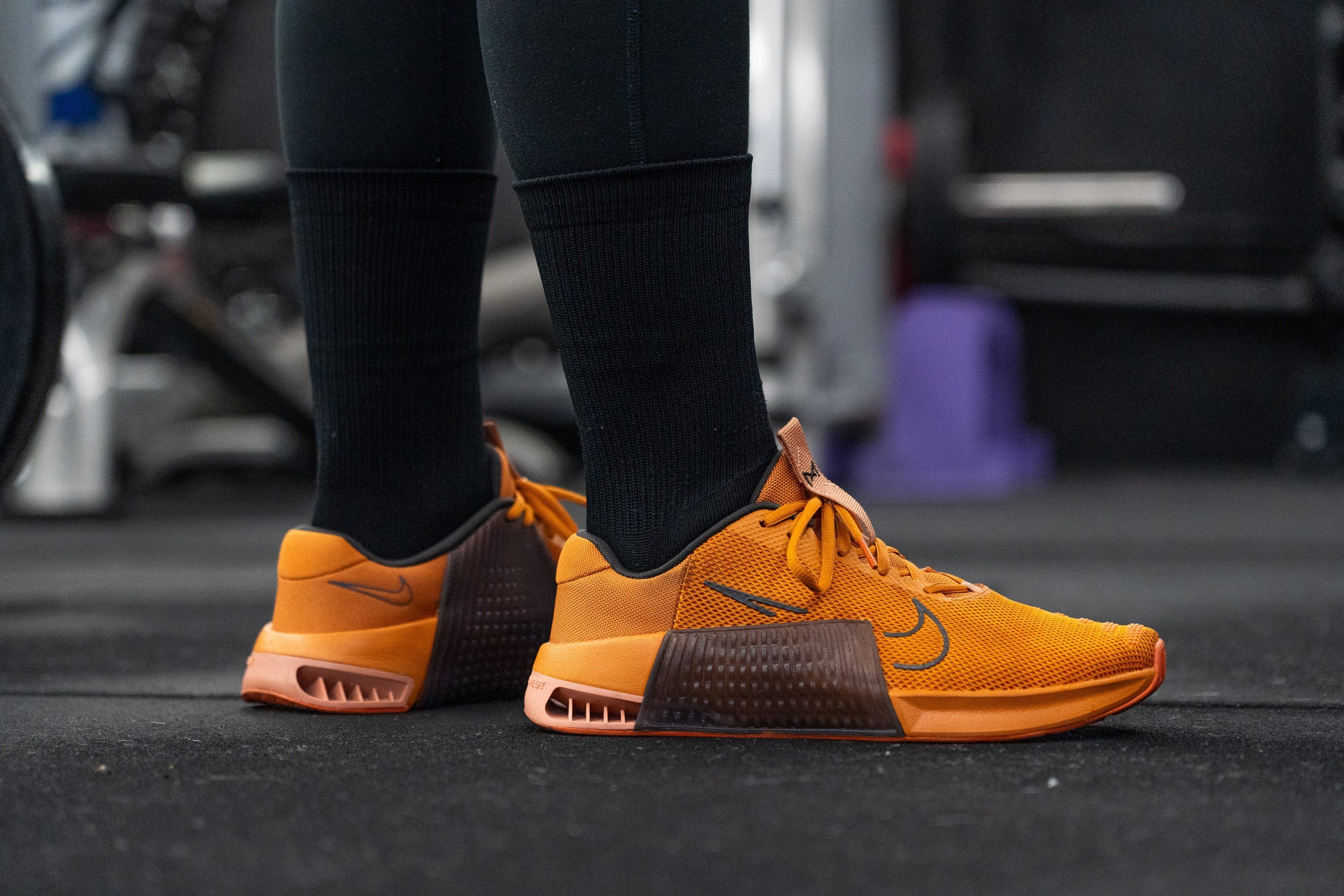
These women’s shoes allow you to transition from cardio to weightlifting effortlessly and feel equally at home in both. They provide sufficient impact protection for explosive box jumps but also keep you steady and surefooted when squatting with a loaded barbell.
Here is a checklist of shoe features to look for in a good cross-trainer for women:
Solid side support: The shoe is rigid in the heel and midfoot and is not easy to twist with your hands (high torsional rigidity).
Wide and firm heel: To keep you stable when working with weights (dumbbells, kettlebells, barbells), you need a wide base to rely on and a midsole that doesn’t compress so easily.
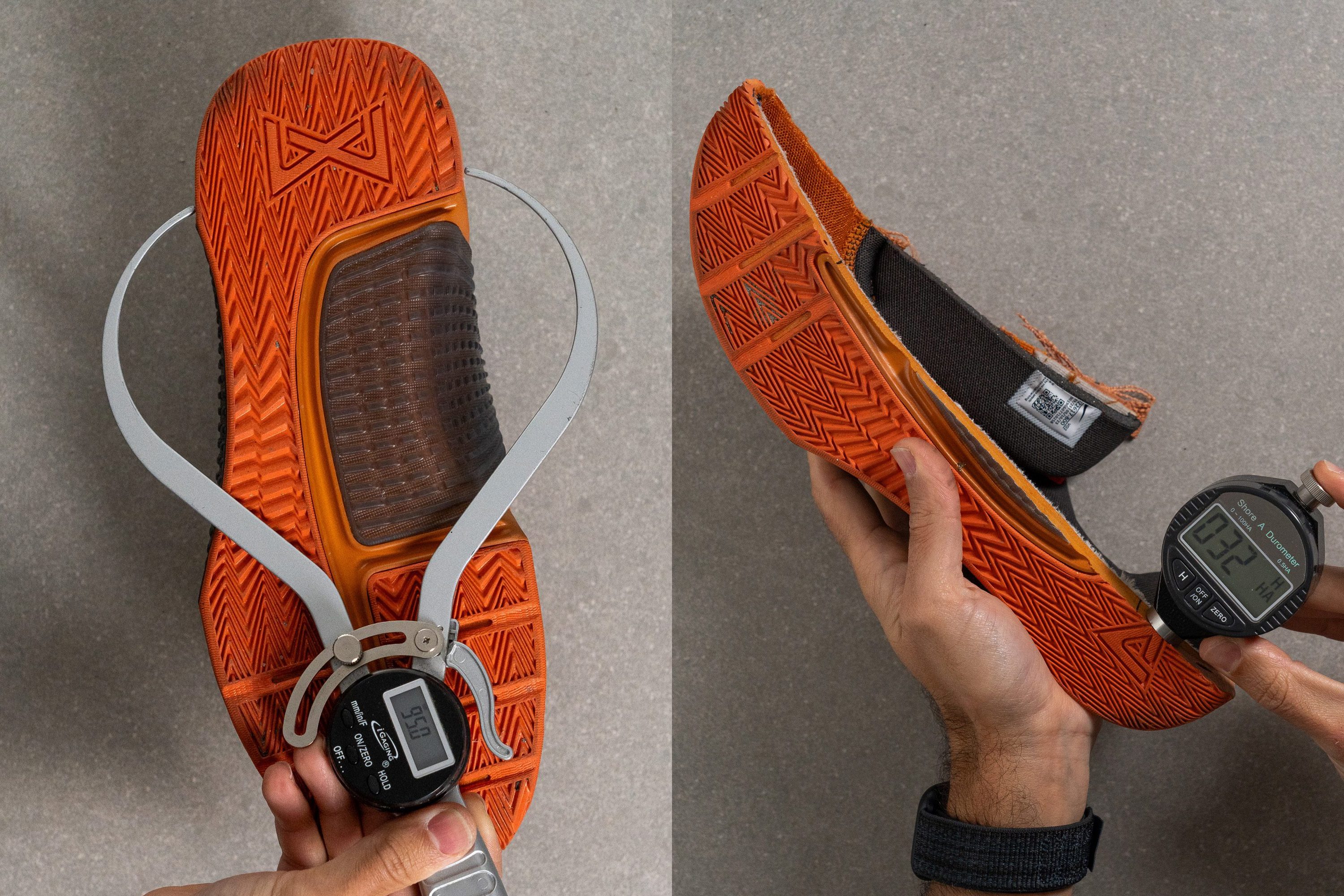
Stiff and padded heel counter: Locking your heel and ankle down in place, a strong heel counter prevents undesirable shifting in the rearfoot. It lowers the risk of foot spills and rolls during side-to-side movements and makes you feel more supported overall.
There are many other shoe features to consider (we will go over them in the sections below) but these 3 are the must-haves of versatile women’s cross-trainers.
We gathered all women’s gym shoes that tick the aforementioned boxes in the table below:
2. Cushioned shoes for high-impact exercises
Best for: aerobics, cardio classes, treadmill, skipping rope
If you love burning as many calories as possible in a fast-paced and high-impact workout routine, your gym shoes should be cushioned accordingly.
In our shoe lab, we measure the shock absorption of all women's gym shoes in both the heel and the forefoot following the ASTM F1976 protocol. The SA measurement we record reflects the amount of impact protection you can expect in a given shoe–the higher the SA score, the better the cushioning.
Thus, a measurement of 90 SA or more in the heel implies maximum shock absorption you can expect in a women's gym shoe.
Shoe lightness is equally important for quick-footed routines. It’s hard to feel agile in a bottom-heavy shoe.
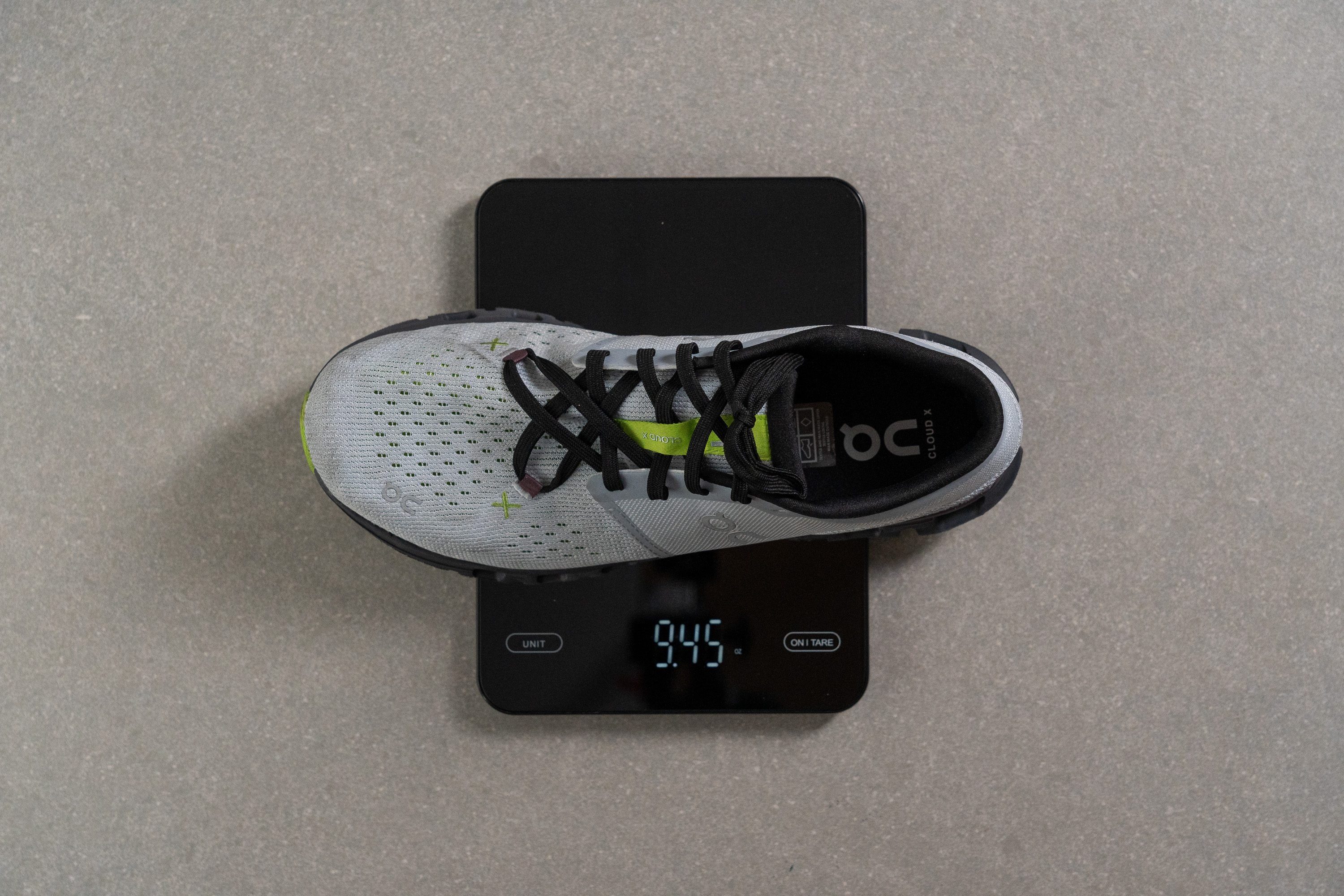
Trainers that weigh 10.6 oz (300g) or less make it to our catalogue of lightweight women’s gym shoes.
3. Minimalist training shoes
Best for: working on foot strength
As a beginner gym goer, we don’t recommend that you get a pair of minimalist trainers from the start.
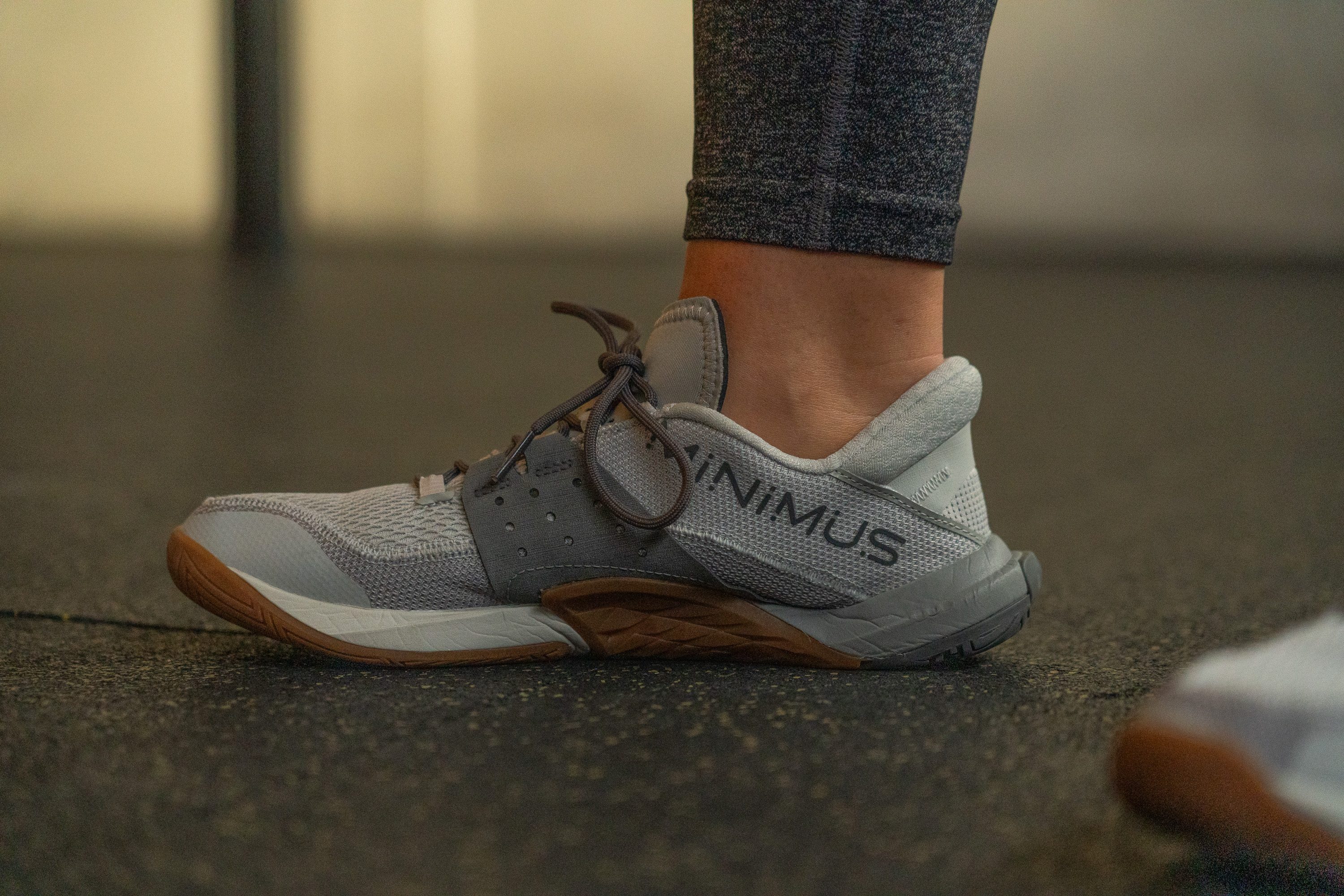
These shoes have no cushioning or additional support and feel almost as if you are training barefoot but with some basic protection from the ground. Seasoned athletes sometimes incorporate these shoes into their rotation to further engage and strengthen their foot and leg muscles.
But please note that these folks have already built a strong foundation and exercise technique and use minimalist shoes as a way to enhance their training. Even they should start slowly and mindfully when switching to minimalist shoes to avoid injury.
Minimalist trainers are easy to detect by the following features:
- Ultra-thin sole (10-15 mm)
- Very flexible (easy to bend and twist)
- Extra lightweight (barely felt on foot)
4. Stable weightlifting shoes
Best for: Olympic weightlifting, powerlifting
Ladies who build their workout routine around strength training and lifting heavy, should look into a pair of dedicated lifting shoes.
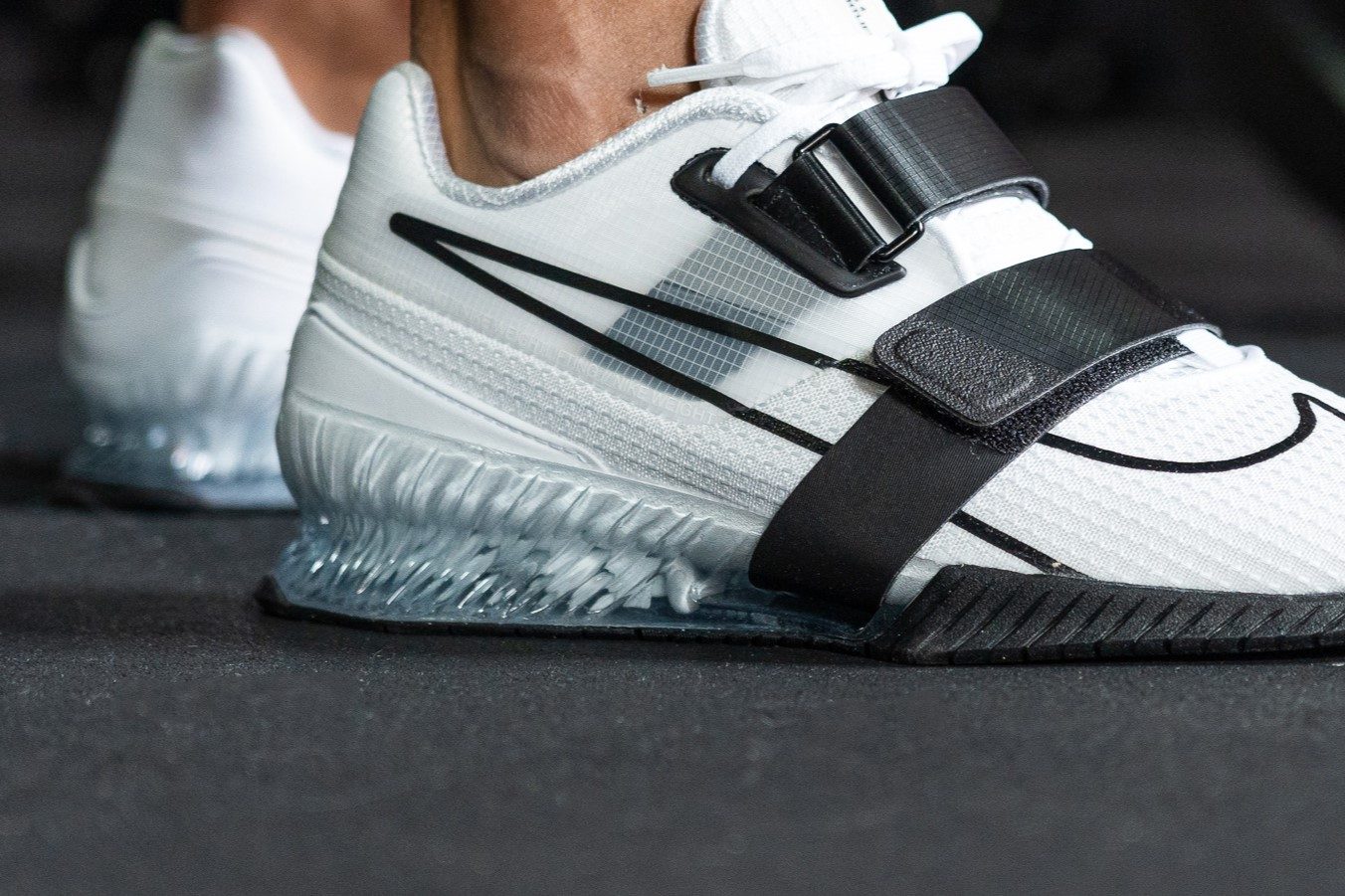
It is a very specialised footwear type which helps to improve your squatting and lifting technique with the following features:
- Raised heel (15-21 mm): enhances ankle mobility and promotes proper squat form
- Rigid platform: no power is lost because the midsole doesn’t compress
- Flat and wide base: very stable and planted experience
- Stiff upper: secure lockdown minimises foot wobbling (often with large Velcro straps)
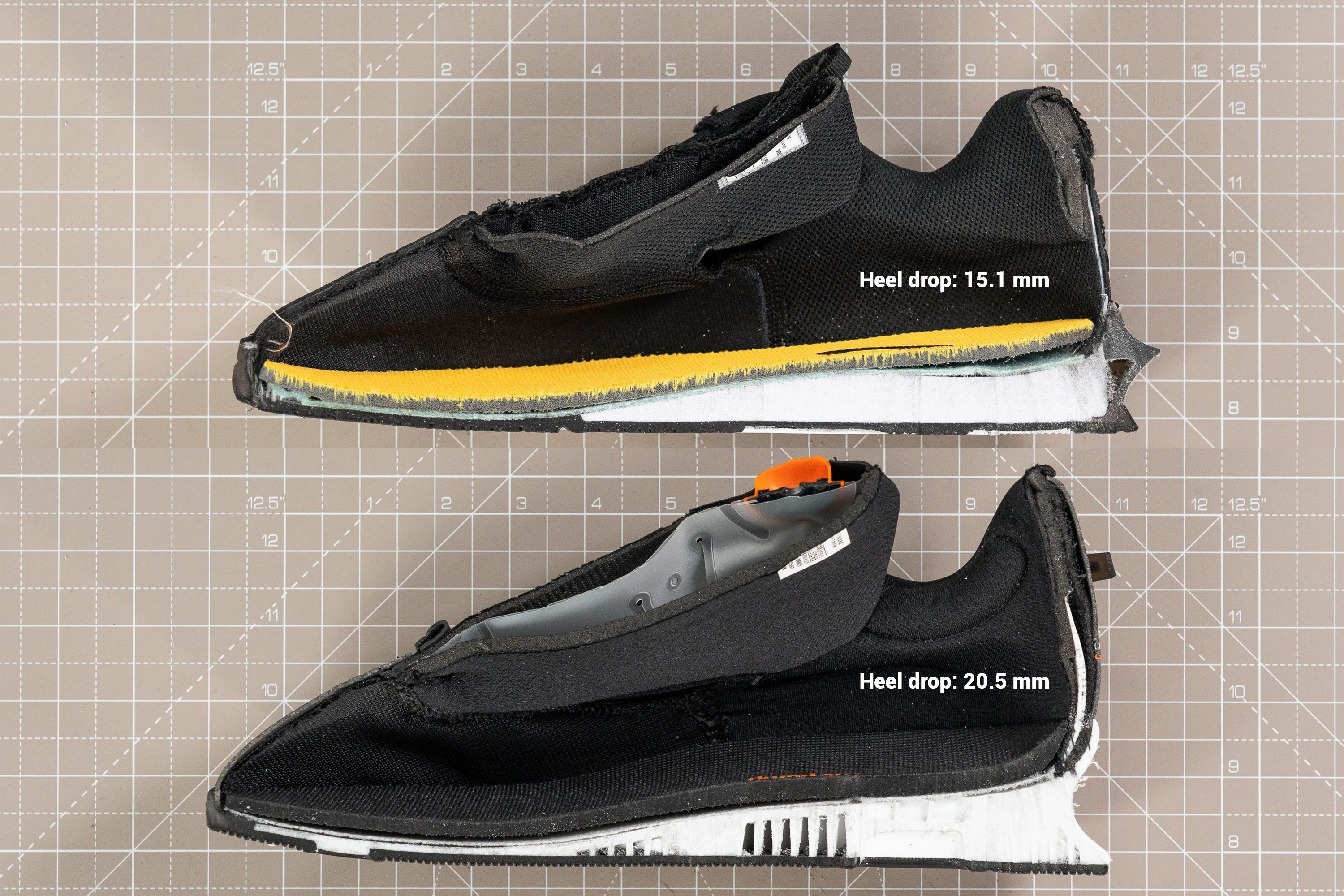
Choosing the right lifting shoe always starts with selecting the appropriate heel-to-toe drop:
- 15-16 mm (0.6 in): best for beginners as the heel elevation is not as dramatic
- 20-21 mm (0.8 in): best for advanced athletes who perform high-skill Olympic lifts and go deeper into squats
How to find the right size and fit in women’s gym shoes
Size: If you have ever tried shoes from several brands at once, you may have noticed that they don’t fit exactly the same, even in the same size.
Because there is no consistency in shoe sizing across all athletic brands, knowing your exact foot length is the best starting point. TIP: Ask a friend to trace your foot for higher accuracy.
Once you have the numbers, you can find out your size in the tool below. It contains official size charts of 40+ brands:
Fit: If you have an average-width foot, the right size almost always implies the right fit as well.
But having tested hundreds of shoes in our lab, we are still amazed at how different shoe toebox shapes can be, even in the same size.
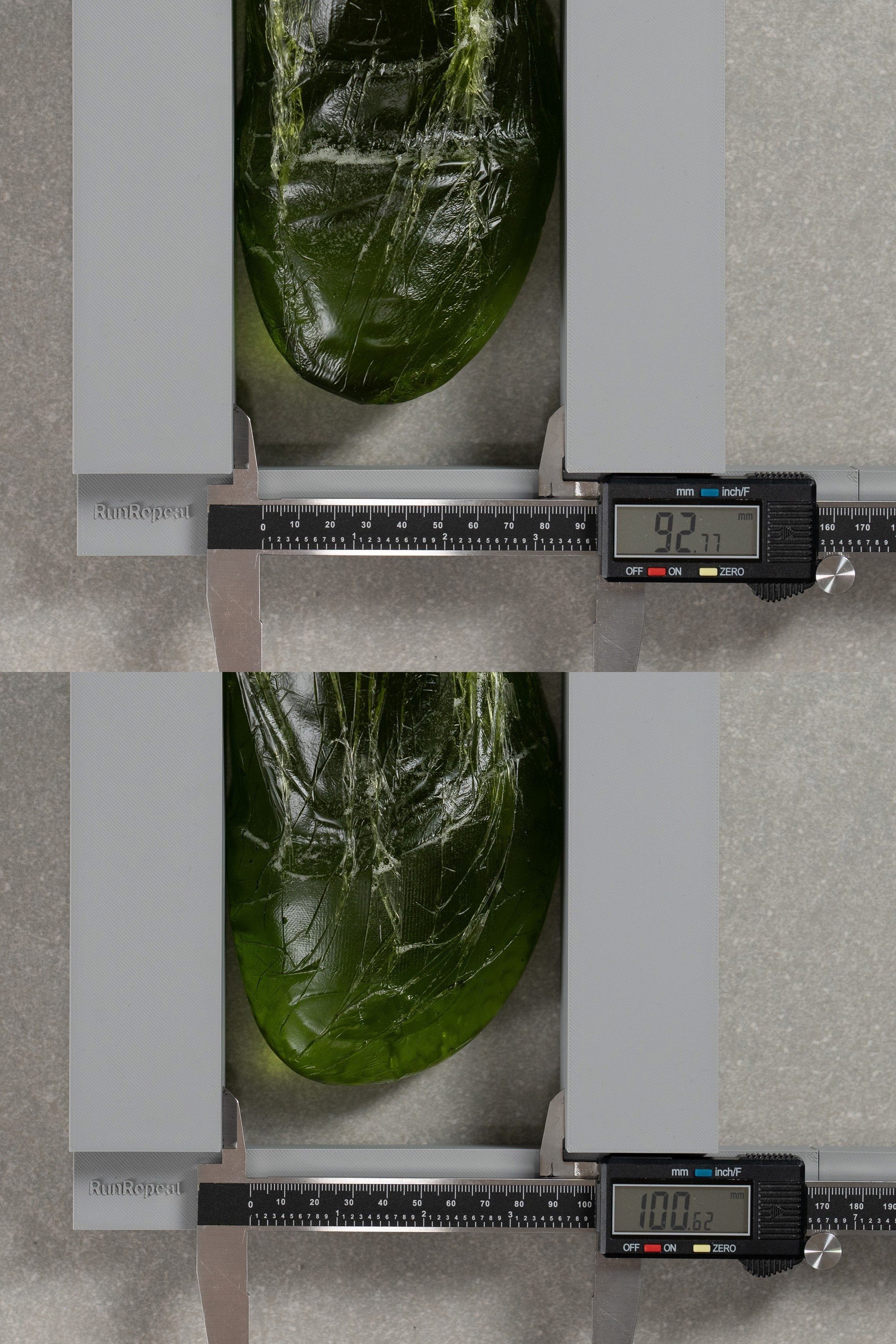
The photo above features gel moulds of two different gym shoes in the same size. As our calliper measurements show, one shoe is a whopping 8 mm wider than the other!
By taking the width dimensions of each tested women’s gym shoe, we aim to let you know how much room to expect.
Here is a quick guide on choosing the right fit in a women’s gym shoe:
|
How to find the right fit in women’s gym shoes |
|
|
Narrow feet |
|
|
Medium feet |
|
|
Wide feet |
+ choose stretchy upper if you have bunions
|
TIP: When trying on new gym shoes, make sure you’re wearing the same socks that you plan to wear when working out.
Detecting a durable gym shoe
You don’t want to spend your hard-earned money on a gym shoe just to see a hole in it only a month later, right?
To avoid that, here is what you should check for:
- wear-resistant upper fabric
- wear-resistant inner lining (especially in the heel area)
- protective rubber or TPU elements (espeically if you do rope climbs)
In our lab, we assess the abrasion resistance of each gym shoe using a Dremel with a sandpaper tip. We apply the latter to various parts of the trainer to see how well it holds up. The smaller the damage, the higher the score.
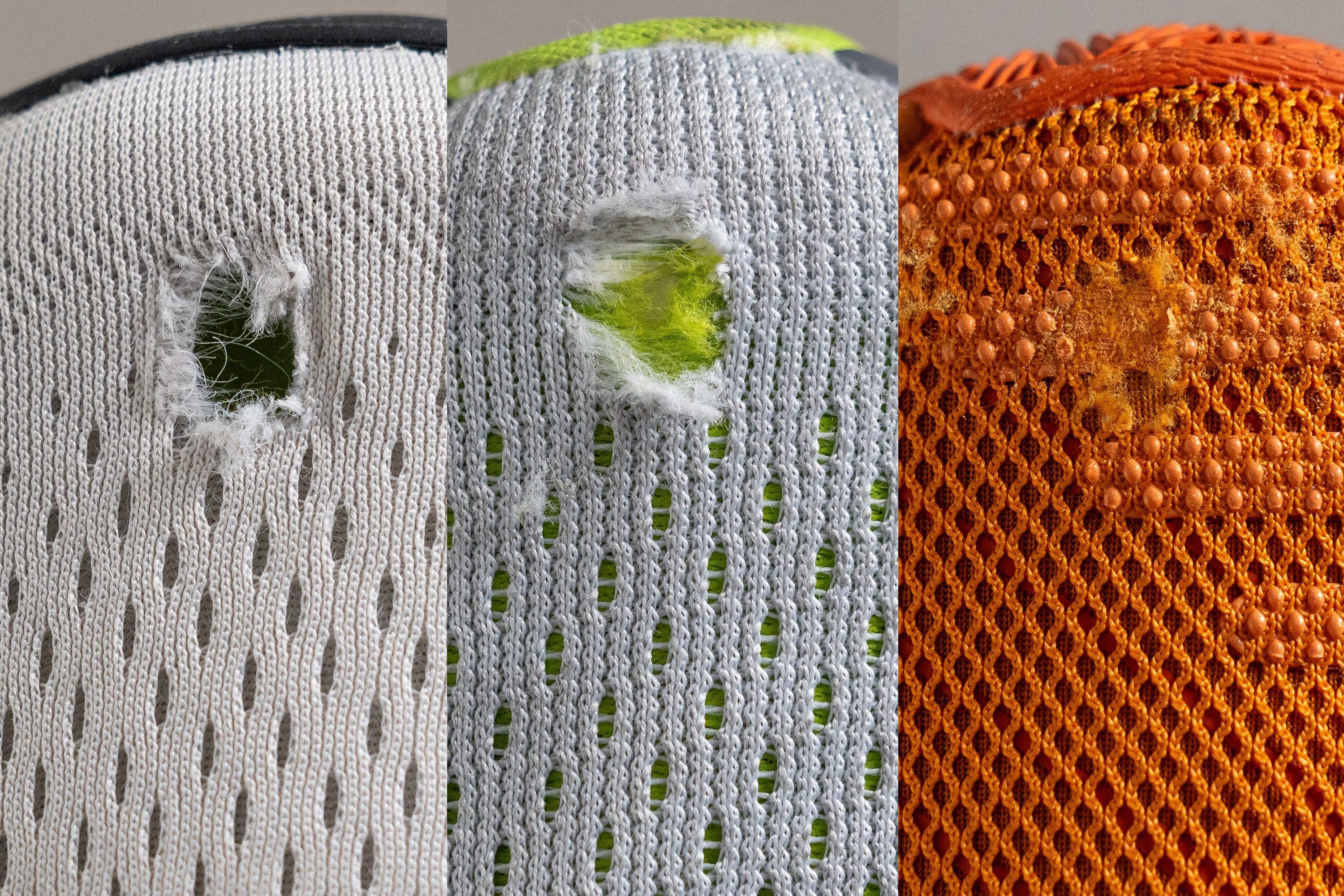
For the outsole, however, we use a tread gauge to measure the actual depth of the dent. In this case, the smaller the number, the stronger the rubber.
The table below features the most durable and abrasion-resistant women’s gym shoes we’ve tested by far:
Can you wear gym shoes outside?
If you want to get as much life as possible out of your gym pair, we wouldn’t recommend wearing it outside the gym.
In addition to faster deterioration, gym shoes don’t make the most comfortable casual shoes either (most of them). They are fine-tuned to keep you stable and steady when working out but feel too flat and overbuilt for walking.
Proper maintenance extends shoe life
Women's gym shoes can last longer and remain in good shape with proper care. Here are a few maintenance tips:
- Regular cleaning: Clean your shoes frequently to get rid of bacteria, sweat, and grime that accumulate over time. Use a moist brush or towel and some mild soap to clean the shoe's outside. Abrasive or strong chemicals should not be used since they can harm the materials of the shoes
- Air dry: Shoes should be air dried in a well-ventilated place after being cleaned or worn. Avoid placing them in the sun or in a hot environment since these conditions can harm the materials in the shoes and cause them to warp or shrink.
- Use a shoe tree: Or stuff the shoes with newspaper to help keep the shape of the shoe and avoid wrinkles while the shoes are not being worn.
- Rotate your shoes: Have a couple of pairs of training shoes that you can rotate to avoid shoes from deteriorating too quickly.
- Ensure proper storage: Place your shoes in a cool, dry area, away from dampness and the sun. Avoid keeping the shoes in a cramped or compact area as this could ruin their form or materials.
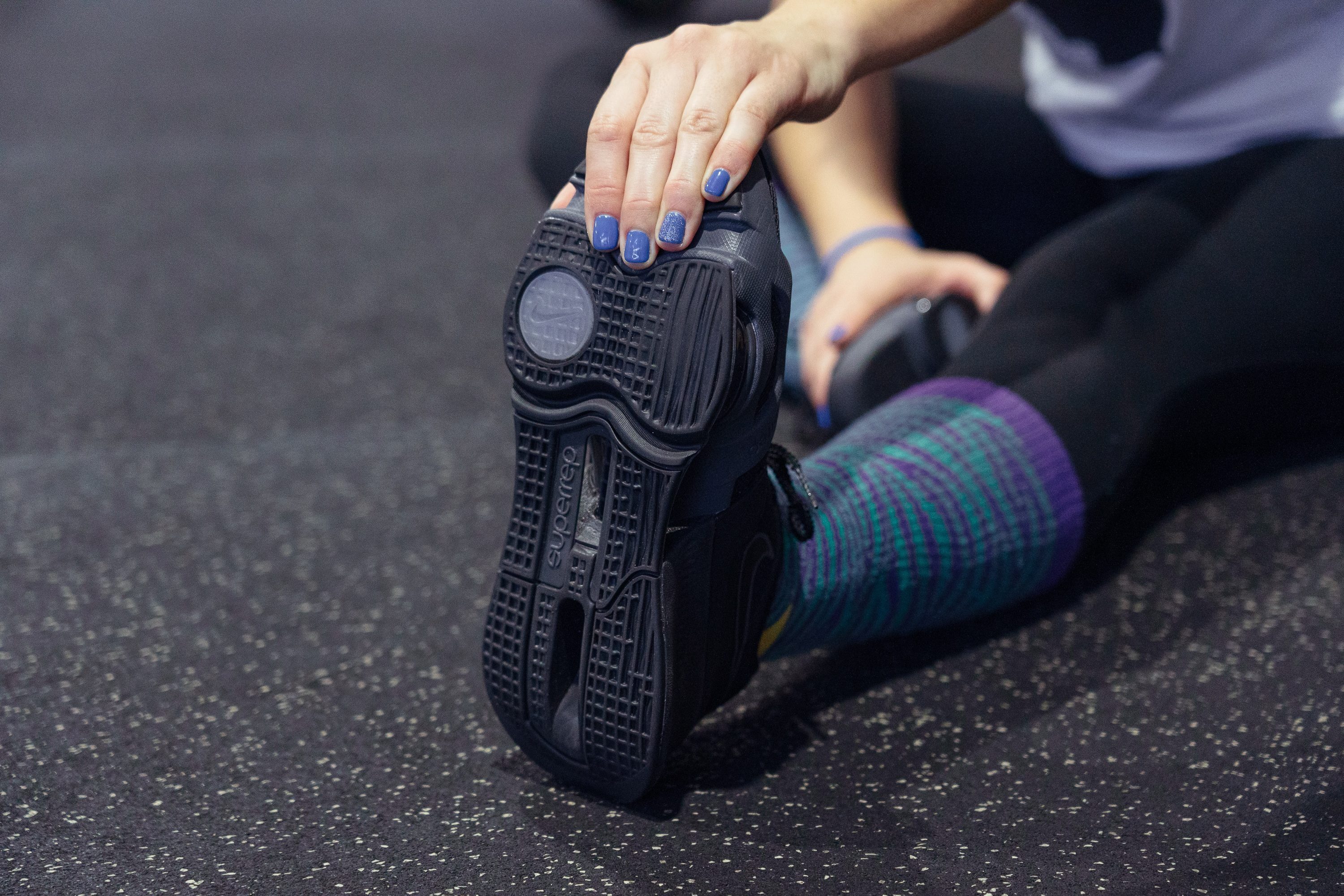
Consider breathability as well
In addition to discomfort, sweaty feet also put you at risk of hot spots, blisters and other foot issues. Sweat can also serve as a breeding ground for bacteria and fungi, increasing the risk of diseases like athlete's foot and producing unpleasant odours.
That’s why it is important to look for gym shoes with proper ventilation.
This is one of the reasons why those leather and suede trainers we see on the feet of fitness influencers so much do not make the best gym shoes.
To help you understand the level of breathability in a given gym shoe, we perform a series of lab tests to check its ventilation capacity.
How to save money on your next pair of women’s gym shoes
The average retail price of a women’s cross-training shoe hovers around £130. This is not a cheap buy, especially for a beginner gym girl.
We are here to let you know that expensive shoes should not be an entry barrier to your fitness goals. Here are a few tips to help you cut costs on the next pair of trainers:
- Compare prices: But you don’t have to manually go through every online shoe because we have done it for you! At RunRepeat, we track prices and sales from 200+ online retailers to let you know where your shoe of choice is offered for less. Set up a price alert on our respective product page to receive an email as soon as the price drops in any of the shops.
- Check previous editions: A newer edition doesn’t always mean a better shoe. In fact, sometimes it’s the other way around! But the moment a new version drops, you can catch a pretty generous markdown for the previous-season shoe (up to 75%!). Just go to our catalogue page of women’s gym shoes and sort by discount.
- Check budget-friendly shoes: Every athletic brand has a line of entry-level shoes that don’t beyond the £100 price point. Here are some of the cheap entry-level gym shoes for women:
